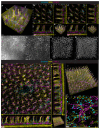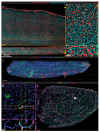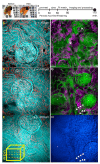This is a preprint.
Depth-Variant Deconvolution Applied to Widefield Microscopy for Rapid Large-Volume Tissue Imaging
- PMID: 40502744
- PMCID: PMC12155202
- DOI: 10.21203/rs.3.rs-6710731/v1
Depth-Variant Deconvolution Applied to Widefield Microscopy for Rapid Large-Volume Tissue Imaging
Abstract
Innovations in 3D tissue imaging have revolutionized research, but limitations stemming from lengthy protocols and equipment accessibility persist. Classical widefield microscopy is fast and accessible but often excluded from 3D imaging workflows due to its lack of optical sectioning. Here we combine tissue clearing with a depth-variant deconvolution approach customized for large-volume widefield imaging to achieve subnuclear axial resolution in tissues to a depth of 500 μm. We illustrate the utility of this method in a mouse model of ileitis and to gain a 3D perspective in thick brain slices from a mouse model of cerebral amyloid angiopathy, where we resolved large and small blood vessels, including those with amyloid deposits, attaining resolution that compared favorably to tile-scanning confocal microscopy. Finally, we sought to leverage our approach to allow for richer pathological evaluation of human kidney biopsies. Our approach produced hundreds of consecutive z-planes in five minutes of imaging for 3D visualization of winding arterioles feeding into glomeruli. This 3D perspective afforded straightforward identification of atrophic tubes in fresh kidney biopsies prepared in 2 hours to simulate the time-constrained evaluation of donor kidneys for transplant suitability. Having achieved subnuclear z-resolution in sections hundreds of microns thick, widefield microscopy coupled to robust deconvolution now emerges as an accessible and viable method to gain 3D insight in research or clinical pathological evaluations.
Conflict of interest statement
Additional Declarations: Yes there is potential Competing Interest. Some of the authors have filed a provisional patent for the ADAPT-3D clearing method used in this manuscript. Declaration of Interests: Some of the authors have filed a provisional patent for the ADAPT3D clearing method used in this manuscript.
Figures




References
-
- Matsumoto K, Mitani TT, Horiguchi SA, Kaneshiro J, Murakami TC, Mano T, Fujishima H, Konno A, Watanabe TM, Hirai H, Ueda HR: Advanced CUBIC tissue clearing for whole-organ cell profiling. Nat Protoc 2019, 14:3506–37. - PubMed
-
- Erturk A, Becker K, Jahrling N, Mauch CP, Hojer CD, Egen JG, Hellal F, Bradke F, Sheng M, Dodt HU: Three-dimensional imaging of solvent-cleared organs using 3DISCO. Nat Protoc 2012, 7:1983–95. - PubMed
-
- Lee DD, Davis DL, Smyth LCD, Telfer KA, Ravindran R, Czepielewski RS, Huckstep CG, Kurashima K, Jain AK, Kipnis J, Zinselmeyer BH, Randolph GJ: ADAPT-3D: Accelerated Deep Adaptable Processing of Tissue for 3-Dimensional Fluorescence Tissue Imaging for Research and Clinical Settings. Research Square (preprint server) 2025. - PMC - PubMed
-
- Shaw PJ: Comparison of Widefield/Deconvolution and Confocal Microscopy for Three-Dimensional Imaging. Handbook of Biological Confocal Microscopy. Edited by Pawley JB. 3rd ed. New York: SpringerScience+Business Media, 2006. pp. 453–67.
Publication types
Grants and funding
LinkOut - more resources
Full Text Sources

